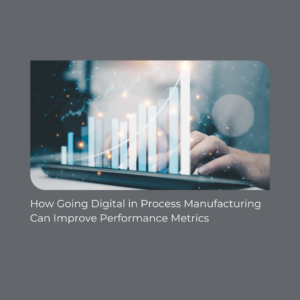From Analog to Analytics
After our visit at the annual IPPE show in Atlanta this year, we found many companies are still struggling with paper problems in their plants. Many times, there are too many touch points, old data stored in filing cabinets around the plant and outdated processes slowing down employees. Going paperless in process manufacturing plants can bring a wealth of benefits, such as improved performance and increased profitability. However, the transition from traditional processes can be daunting. The key is to start small and work towards the goal of gaining control over your plant’s data.
One of the main reasons that many process manufacturing plants have not yet gone paperless is the belief that companies simply haven’t caught up with technology. However, this is not the case, when many times it is simply the technology that cannot conform to the process. The complexity of process manufacturing, with the vast amount of data that flows through the facility, makes it difficult to wrangle all the information without the aid of technology. This is especially true when relying on paperwork, which can make it near-impossible to leverage data effectively.
Consider the data sources that your facility may have: operators, non-regulatory, ERP, suppliers, operations (SOPs), software (inventory/WMS), customers, labs, regulatory, equipment/PLCs. The outputs required for using and making sense of all this data can also be varied, including forms/checklists, records, inspections, tasks, reports, verifications, documents, audits, certifications. To make matters more complex, this information can come in a variety of formats, including paper, email, spreadsheets, and images, and may be located in various places, such as file cabinets, shared drives, or even on an employee’s desk.
In order to leverage data effectively, it is crucial to have a system in place that allows for easy access and management of data. Using paper, point solutions, or a combination of both, impedes visibility into all the information that your operation is generating. However, the pursuit of gaining control over your data is certainly worthwhile, as it is one of the most valuable assets that your company has, aside from your people and products.
For a company that has been doing things a certain way for years, this data challenge can be overwhelming. However, there is a simple way to approach it. Start by considering the three questions mentioned earlier: Can you capture the data you need right now? Can you find data when you need it? Can you use that data for real-time decision making?
The path towards digital production plans in process manufacturing can be broken down into three steps: Data Collection, Data Management, and Data Analysis.
Data Collection: This includes digitizing data collection on the plant floor and considering ways to digitize data from suppliers and customers. For example, operators on the plant floor can use mobile devices, such as tablets or phones, to scan and input data, while suppliers and customers can use portals to share and collect information. Outside of manual, digital data collection, machine data can be extracted from PLCs and other IOT devices wirelessly for automated data collection. Additionally, regulatory, non-regulatory, and operations/programs (SOPs) can use a web-based system to upload and manage data.
Data Management: This involves having a system in place to easily find and access data when needed. This can include implementing a digital document management system, or using cloud-based solutions to store and share data through recurring reports. Having a centralized location for data storage and a system that can report on key data at any moment can make it much easier to find the information you need, when you need it.
Data Analysis: This is where the magic happens, using data for powerful, real-time decision making that improves processes across the facility. By analyzing data, you can gain valuable insights into the performance of your plant and identify areas for improvement. This can include monitoring production efficiency, identifying bottlenecks, and tracking inventory levels with customized KPIs.
It’s important to note that the process of going paperless is not just about replacing clipboards with tablets, but also digitizing data from suppliers and customers, using a web-based system for regulatory and non-regulatory data, and implementing mobile devices for operators. By taking a comprehensive approach to digitization, you can ensure that all aspects of your data collection, management, and analysis are covered.
One of the main advantages of going paperless is the ability to gain real-time visibility into the performance of your plant. With digital systems in place, you can monitor production in real-time and make adjustments as needed. This can help to improve efficiency, reduce downtime, and ultimately increase profitability. Additionally, by digitizing data from suppliers and customers, you can improve communication and collaboration, leading to better relationships and increased revenue.
Another advantage of going paperless is the ability to easily comply with regulatory requirements. With digital systems in place, it is much easier to track and manage compliance-related data, such as certifications, inspections, and audits. This can help to reduce the risk of non-compliance and associated fines.
BluWave is making a large impact on bringing our production and quality systems into the 21st century.”
– Quality Manager, Meat Processing Facility
In conclusion, going paperless in process manufacturing plants can bring a wealth of benefits, such as improved performance and increased profitability. However, the transition from traditional processes can be daunting. The key is to start small and work towards the goal of gaining control over your plant’s data. By considering the three main steps of data collection, management, and analysis, you can ensure that all aspects of digitization are covered. By implementing digital systems, you can gain real-time visibility into the performance of your plant, improve communication and collaboration, and easily comply with regulatory requirements. Get in touch with an expert for your customized digital-transformation plan!
